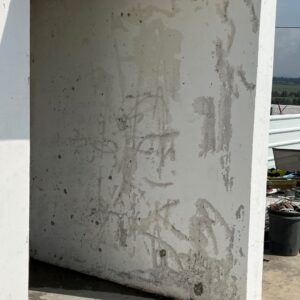Note: This is the third article of TC Jewfolk Editor Lonny Goldsmith’s trip to Israel with UpStart and iCenter’s “A Mifgash that Matters,” which is being put on in partnership with The Jewish Education Project and in collaboration with The Jewish Agency for Israel and made possible through support from the Jim Joseph Foundation. Read more: Part 1 | Part 2
NETIV HA’ASARA, Israel – Yoni Shaked leads a group of people through Moshav Netiv Ha’asara, a small, tight-knit community of 300 families – more than 1,000 people – on the northern border of Gaza. In between her words, birds chirping, and the occasional truck from a farmer that drives by, small arms fire can be heard from Gaza.

Yoni Shaked gives visitors a tour of Netiv Ha’asara, the moshav she grew up on. (Photo by Lonny Goldsmith/TC Jewfolk).
Some of her guests flinch. She is nonplussed and keeps talking. This has been the soundtrack to the lives of the community since it was put on the frontline when the IDF withdrew in 2005.
The community where Shaked grew up was one of the first hit when Hamas terrorists attacked Israel on Oct. 7. Three paragliders flew from Gaza into the moshav. Shaked led the group along the path the terrorists took through the community, where they killed 20 residents – 17 in the village, two at nearby Zakim Beach, and another teen who was biking nearby.
Shaked points to the shelter where Chavik Segal, 78, was shot nine times. She ran across the street from her older home without a secure shelter structure to one of the many out in the open. But she was spotted going in as terrorists advanced up the street.
Shaked led the group to a house with the shells of two rusted cars in the driveway, burnt when the home of Yakovi and Bilha Inon was destroyed by a rocket-propelled grenade. One of their bodies was identified, but both were reportedly in the house at the time. Shaked said they were an elderly couple that frequently helped by taking Gazan children to hospitals in Israel for care.
“October 7 didn’t care,” she said. “Visitor [or] resident, Muslim [or] Jew, left [or] right.”
The next house was the only one in the community that offered video evidence of what took place on Oct. 7. Gil Ta’aseh used to be the community security chief before becoming an officer in the fire department. He had closed circuit TV cameras on his house – with sound. Ta’aseh’s death was part of a nearly 43-minute video compiled by the Israeli government from Hamas body cameras, dashboard cameras, social media, as well as Israeli rescuers, other closed-circuit television cameras, and the phones of Israelis – rescuers and victims alike.

The inside of Gil Ta’aseh’s shelter. He threw himself on a grenade to save the lives of two of his sons. (Photo by Lonny Goldsmith/TC Jewfolk).
Ta’aseh threw himself on a grenade in his shelter to save his two sons. One of the two lost sight in one eye from shrapnel. The video shows the two boys being taken into the house by the terrorists, who took food and drink out of the fridge before leaving. One of his sons said to the other “I don’t want to be alive.” Ta’aseh’s older son was one of the two killed at the beach.
One of the final visits was to the spot the community is most well-known for: The Path To Peace wall art project. Designed on large concrete wall used to shield residents from sniper fire, The words Path to Peace are written in English, Hebrew, and Arabic. Shaked said she’s not sure if Tsameret Zamir will resume the project.
What’s next
Now the 300 families are gone, dispersed around Israel, and the moshav is now a closed military space. For how long? Maybe July 7. Maybe later. Shaked doesn’t know.
“I trust my community,” she said. “If most move back, I would. But I won’t be first.”
Shaked said that only 2 percent said they won’t be back when they are allowed back in – most of that group had been in the village for fewer than three years. Forty percent said they’d immediately return. Many are uncertain about what their next steps will be, which is nothing new after four months of uncertainty.
In Tel Aviv, many of the residents are living temporarily in a high-end hotel on the beach, but it is no vacation. Shaked says they are village people being dropped into a large city. But the timing of the attacks and decisions of what to do next has deeply impacted the kids of the community.
Einat Khalon, a parent of a Herzl camper who is returning to Webster, Wis., for six weeks this summer, is in charge of the education right now. A lawyer by trade, Khalon said that people choosing to go to housing in Ashkelon next month, after starting the school year on the moshav and then transferring to schools around Tel Aviv, is a shock to the system.
“Friends don’t stay together and it’s hard on parents and children,” she said. “It feels like everything is temporary and they won’t let themselves open up.”
Khalon said that many of the kids in the moshav know everything about what happened on Oct. 7, but not because their parents want them to.
“They know everything, I’m embarrassed to say, because of TikTok and WhatsApp groups,” Khalon said. “My children told me who died. We didn’t have any control.”
Said Shaked: “It’s impossible to shield them. In a hotel room, there’s no privacy. Any conversation, they know.”
Before departing the moshav to travel to Tel Aviv, the bus brought Shaked’s group back to the shelter where Segal was killed to say Mourner’s Kaddish for Segal and the others who were killed on Oct. 7. As the last note faded, artillery fire could be heard in the distance; the soundtrack to life on the border.


















1 comment